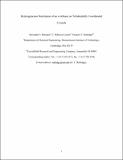| dc.contributor.author | Locker, C. Rebecca | |
| dc.contributor.author | Bourque, Alexander Jules | |
| dc.contributor.author | Rutledge, Gregory C | |
| dc.date.accessioned | 2018-01-08T19:00:48Z | |
| dc.date.available | 2018-01-08T19:00:48Z | |
| dc.date.issued | 2017-01 | |
| dc.date.submitted | 2016-12 | |
| dc.identifier.issn | 1520-6106 | |
| dc.identifier.issn | 1520-5207 | |
| dc.identifier.uri | http://hdl.handle.net/1721.1/113021 | |
| dc.description.abstract | Heterogeneous nucleation refers to the propensity for phase transformations to initiate preferentially on foreign surfaces, such as vessel walls, dust particles, or formulation additives. In crystallization, the form of the initial nucleus has ramifications for the crystallographic form, morphology, and properties of the resulting solid. Nevertheless, the discovery and design of nucleating agents remains a matter of trial and error because of the very small spatiotemporal scales over which the critical nucleus is formed and the extreme difficulty of examining such events empirically. Using molecular dynamics simulations, we demonstrate a method for the rapid screening of entire families of materials for activity as nucleating agents and for characterizing their mechanism of action. The method is applied to the crystallization of n-pentacontane, a model surrogate for polyethylene, on the family of tetrahedrally coordinated crystals, including diamond and silicon. A systematic variation of parameters in the interaction potential permits a comprehensive, physically based screening of nucleating agents in this class of materials, including both real and hypothetical candidates. The induction time for heterogeneous nucleation is shown to depend strongly on crystallographic registry between the nucleating agent and the critical nucleus, indicative of an epitaxial mechanism in this class of materials. Importantly, the severity of this registry requirement weakens with decreasing rigidity of the substrate and increasing strength of attraction to the surface of the nucleating agent. Employing this method, a high-throughput computational screening of nucleating agents becomes possible, facilitating the discovery of novel nucleating agents within a broad “materials genome” of possible additives. | en_US |
| dc.description.sponsorship | National Science Foundation (U.S.) (Award CMMI-1235109) | en_US |
| dc.language.iso | en_US | |
| dc.publisher | American Chemical Society (ACS) | en_US |
| dc.relation.isversionof | http://dx.doi.org/10.1021/acs.jpcb.6b12590 | en_US |
| dc.rights | Article is made available in accordance with the publisher's policy and may be subject to US copyright law. Please refer to the publisher's site for terms of use. | en_US |
| dc.source | Prof. Rutledge via Erja Kajosalo | en_US |
| dc.title | Heterogeneous Nucleation of an n-Alkane on Tetrahedrally Coordinated Crystals | en_US |
| dc.type | Article | en_US |
| dc.identifier.citation | Bourque, Alexander J., C. Rebecca Locker, and Gregory C. Rutledge. “Heterogeneous Nucleation of an n-Alkane on Tetrahedrally Coordinated Crystals.” The Journal of Physical Chemistry B 121, 4 (January 2017): 904–911 © 2017 American Chemical Society | en_US |
| dc.contributor.department | Massachusetts Institute of Technology. Department of Chemical Engineering | en_US |
| dc.contributor.approver | Rutledge, Gregory C. | en_US |
| dc.contributor.mitauthor | Bourque, Alexander Jules | |
| dc.contributor.mitauthor | Rutledge, Gregory C | |
| dc.relation.journal | The Journal of Physical Chemistry B | en_US |
| dc.eprint.version | Author's final manuscript | en_US |
| dc.type.uri | http://purl.org/eprint/type/JournalArticle | en_US |
| eprint.status | http://purl.org/eprint/status/PeerReviewed | en_US |
| dspace.orderedauthors | Bourque, Alexander J.; Locker, C. Rebecca; Rutledge, Gregory C. | en_US |
| dspace.embargo.terms | N | en_US |
| dc.identifier.orcid | https://orcid.org/0000-0001-9074-844X | |
| dc.identifier.orcid | https://orcid.org/0000-0001-8137-1732 | |
| mit.license | PUBLISHER_POLICY | en_US |
